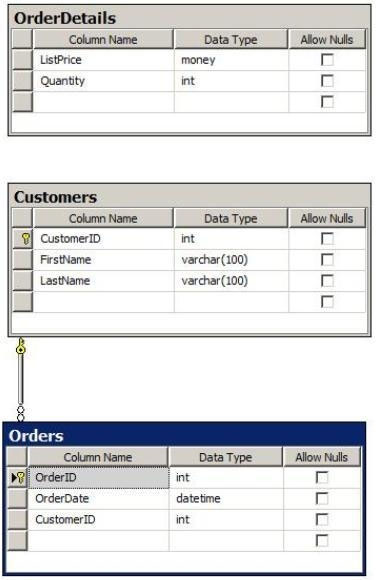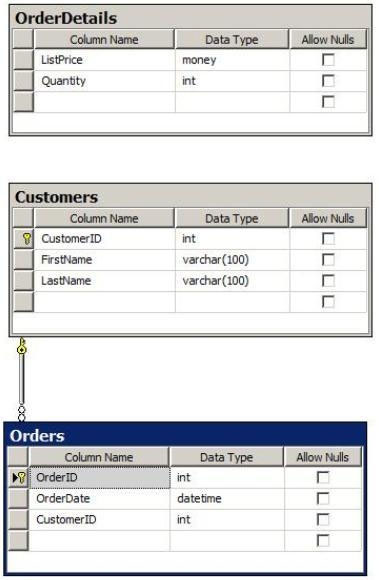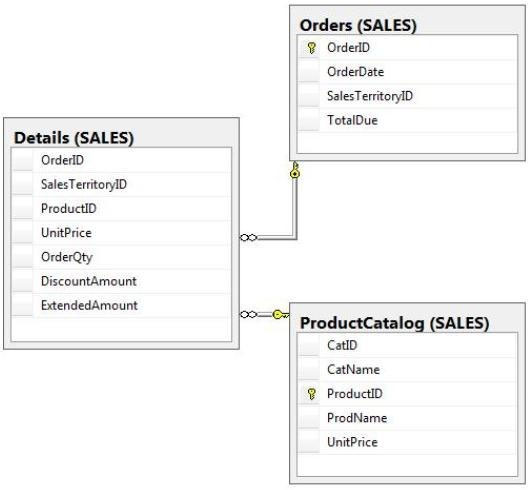Microsoft 70-461 Exam Practice Questions (P. 2)
- Full Access (265 questions)
- One Year of Premium Access
- Access to one million comments
- Seamless ChatGPT Integration
- Ability to download PDF files
- Anki Flashcard files for revision
- No Captcha & No AdSense
- Advanced Exam Configuration
Question #6
SIMULATION -
You have a database that contains the tables shown in the exhibit. (Click the Exhibit button.)

You deploy a new server that has SQL Server 2012 installed. You need to create a table named
Sales.OrderDetails on the new server. Sales.OrderDetails must meet the following requirements:
✑ Write the results to a disk.
✑ Contain a new column named LineItemTotal that stores the product of ListPrice and Quantity for each row.
✑ The code must NOT use any object delimiters.
The solution must ensure that LineItemTotal is stored as the last column in the table. Which code segment should you use?
To answer, type the correct code in the answer area.
You have a database that contains the tables shown in the exhibit. (Click the Exhibit button.)

You deploy a new server that has SQL Server 2012 installed. You need to create a table named
Sales.OrderDetails on the new server. Sales.OrderDetails must meet the following requirements:
✑ Write the results to a disk.
✑ Contain a new column named LineItemTotal that stores the product of ListPrice and Quantity for each row.
✑ The code must NOT use any object delimiters.
The solution must ensure that LineItemTotal is stored as the last column in the table. Which code segment should you use?
To answer, type the correct code in the answer area.
Correct Answer:
Please review the explanation part for this answer.
CREATE TABLE Sales.OrderDetails (
ListPrice money not null,
Quantity int not null,
LineItemTotal as (ListPrice * Quantity) PERSISTED
)
Reference:
http://msdn.microsoft.com/en-us/library/ms174979.aspx
http://technet.microsoft.com/en-us/library/ms188300.aspx
Please review the explanation part for this answer.
CREATE TABLE Sales.OrderDetails (
ListPrice money not null,
Quantity int not null,
LineItemTotal as (ListPrice * Quantity) PERSISTED
)
Reference:
http://msdn.microsoft.com/en-us/library/ms174979.aspx
http://technet.microsoft.com/en-us/library/ms188300.aspx
send
light_mode
delete
Question #7
SIMULATION -
You have a database that contains the tables shown in the exhibit. (Click the Exhibit button.)

You need to create a view named uv_CustomerFullName to meet the following requirements:
The code must NOT include object delimiters.

✑ The view must be created in the Sales schema.
✑ Columns must only be referenced by using one-part names.
✑ The view must return the first name and the last name of all customers.
✑ The view must prevent the underlying structure of the customer table from being changed.
✑ The view must be able to resolve all referenced objects, regardless of the user's default schema.
Which code segment should you use?
To answer, type the correct code in the answer area.
You have a database that contains the tables shown in the exhibit. (Click the Exhibit button.)

You need to create a view named uv_CustomerFullName to meet the following requirements:
The code must NOT include object delimiters.

✑ The view must be created in the Sales schema.
✑ Columns must only be referenced by using one-part names.
✑ The view must return the first name and the last name of all customers.
✑ The view must prevent the underlying structure of the customer table from being changed.
✑ The view must be able to resolve all referenced objects, regardless of the user's default schema.
Which code segment should you use?
To answer, type the correct code in the answer area.
Correct Answer:
Please review the explanation part for this answer.
CREATE VIEW Sales.uv_CustomerFullName
WITH SCHEMABINDING -
AS -
SELECT FirstName, LastName -
FROM Sales.Customers -
Reference:
http://msdn.microsoft.com/en-us/library/ms187956.aspx
Please review the explanation part for this answer.
CREATE VIEW Sales.uv_CustomerFullName
WITH SCHEMABINDING -
AS -
SELECT FirstName, LastName -
FROM Sales.Customers -
Reference:
http://msdn.microsoft.com/en-us/library/ms187956.aspx
send
light_mode
delete
Question #8
SIMULATION -
You have a database that contains the tables shown in the exhibit. (Click the Exhibit button.)

You need to create a query that calculates the total sales of each OrderId from the Sales.Details table. The solution must meet the following requirements:
✑ Use one-part names to reference columns.
✑ Sort the order of the results from OrderId.
✑ NOT depend on the default schema of a user.
✑ Use an alias of TotalSales for the calculated ExtendedAmount.
✑ Display only the OrderId column and the calculated TotalSales column.
Which code segment should you use?
To answer, type the correct code in the answer area.
You have a database that contains the tables shown in the exhibit. (Click the Exhibit button.)

You need to create a query that calculates the total sales of each OrderId from the Sales.Details table. The solution must meet the following requirements:
✑ Use one-part names to reference columns.
✑ Sort the order of the results from OrderId.
✑ NOT depend on the default schema of a user.
✑ Use an alias of TotalSales for the calculated ExtendedAmount.
✑ Display only the OrderId column and the calculated TotalSales column.
Which code segment should you use?
To answer, type the correct code in the answer area.
Correct Answer:
Please review the explanation part for this answer.
SELECT OrderID, SUM(ExtendedAmount) AS TotalSales
FROM Sales.Details -
GROUP BY OrderID -
ORDER BY OrderID
Please review the explanation part for this answer.
SELECT OrderID, SUM(ExtendedAmount) AS TotalSales
FROM Sales.Details -
GROUP BY OrderID -
ORDER BY OrderID
send
light_mode
delete
Question #9
You have a Microsoft SQL Server database that contains tables named Customers and Orders.
The tables are related by a column named CustomerID.
You need to create a query that meets the following requirements:
✑ Returns the CustomerName for all customers and the OrderDate for any orders that they have placed.
✑ Results must include customers who have not placed any orders.
Which Transact-SQL query should you use?
The tables are related by a column named CustomerID.
You need to create a query that meets the following requirements:
✑ Returns the CustomerName for all customers and the OrderDate for any orders that they have placed.
✑ Results must include customers who have not placed any orders.
Which Transact-SQL query should you use?
- ASELECT CustomerName, OrderDate FROM Customers RIGHT OUTER JOIN Orders ON Customers.CustomerID = Orders.CustomerID
- BSELECT CustomerName, OrderDate FROM Customers JOIN Orders ON Customers.CustomerID = Orders.CustomerID
- CSELECT CustomerName, OrderDate FROM Customers CROSS JOIN Orders ON Customers.CustomerID = Orders.CustomerID
- DSELECT CustomerName, OrderDate FROM Customers LEFT OUTER JOIN Orders ON Customers.CustomerID = Orders.CustomerID
Correct Answer:
D
Reference:
http://msdn.microsoft.com/en-us/library/ms177634.aspx
D
Reference:
http://msdn.microsoft.com/en-us/library/ms177634.aspx
send
light_mode
delete
Question #10
You create a stored procedure that will update multiple tables within a transaction.
You need to ensure that if the stored procedure raises a run-time error, the entire transaction is terminated and rolled back.
Which Transact-SQL statement should you include at the beginning of the stored procedure?
You need to ensure that if the stored procedure raises a run-time error, the entire transaction is terminated and rolled back.
Which Transact-SQL statement should you include at the beginning of the stored procedure?
- ASET XACT_ABORT ON
- BSET ARITHABORT ON
- CTRY
- DBEGIN
- ESET ARITHABORT OFF
- FSET XACT_ABORT OFF
Correct Answer:
A
Reference:
http://msdn.microsoft.com/en-us/library/ms190306.aspx
http://msdn.microsoft.com/en-us/library/ms188792.aspx
A
Reference:
http://msdn.microsoft.com/en-us/library/ms190306.aspx
http://msdn.microsoft.com/en-us/library/ms188792.aspx
send
light_mode
delete
All Pages
